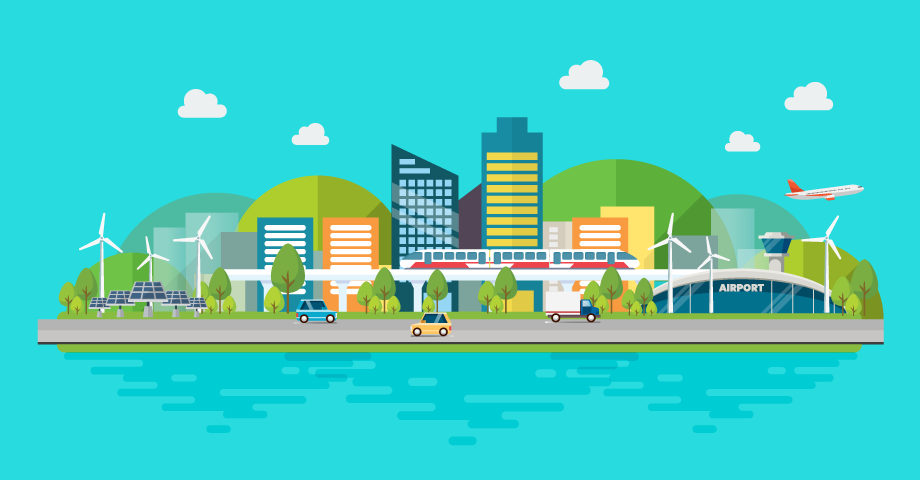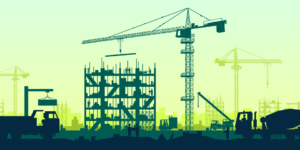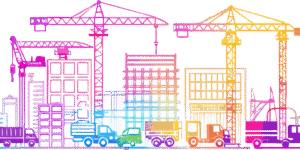Mixed-use development projects are a cornerstone of sustainable urban planning, providing high-density housing near transportation and promoting walkable communities. Green initiatives are continuing to shape the future of mixed-use construction, and your development team will want to stay out front of these trends. From Leadership in Energy and Environmental Design (LEED) certification to adaptive reuse, eco-friendly building practices can provide both environmental and economic benefits for your projects.
Green building techniques outlined in the EPA’s smart growth guidance, which shows how you can mitigate environmental impact in the construction process, are uniquely aligned with mixed-use development projects. The EPA recommends green buildings repurpose existing infrastructure, preserve green space, and put homes, parks, schools, and jobs close to each other. By Implementing green initiatives in the construction process you can ensure your buildings both contribute positively to communities and guarantee long-term returns.
Here are the green initiatives shaping the future of mixed-use development construction, and how your team can overcome potential challenges in the process:
LEED-Certification for Mixed-Use Developments
LEED is a certification granted to building owners or designers to help demonstrate the sustainability of a project. Bob Berkebile, an architect known for sustainable design, collaborated with the EPA in 1993 to establish the United States Green Building Council (USGBC) and implement the LEED certification program. LEED has since expanded into a global project, with over 180 countries using the certification system and embracing sustainable practices in building construction.
Mixed-use developments pursuing LEED certification will need to make considerations as early as pre-development, as the process requires thorough documentation to show compliance. Buildings will need to show proficiency in:
- Overall Sustainability
- Water Efficiency
- Energy consumption and greenhouse gas emissions
- Indoor environment and air quality
- Overall carbon footprint
Once your project is submitted for LEED certification, a committee will evaluate the building to determine if it meets the prerequisites for green building certification.
By incorporating additional sustainable design elements into a project your team can be awarded additional points and reach a more desirable certification status such as silver-certified, gold-certified, or platinum-certified. LEED-certified buildings have a marketing advantage – tenants want to live in eco-friendly spaces with clean air quality, and vacancy rates are 4% lower than non-green buildings. LEED buildings also have the highest rent and lease-up rates, coming in approximately 20% above average.
Investors may also be drawn to green buildings due to associated benefits, including low operating costs and reduced carbon emissions that can help them reach Environment, Social, and Governance (ESG) goals. In many states, LEED-certified buildings are also eligible for tax incentives that can help offset the upfront costs of the sustainability features needed to qualify for higher tiers.
Zero Energy Buildings
Zero energy buildings, where the total energy consumed is equivalent to the renewable energy generated on-site, are becoming more common among new commercial construction. By reducing overall energy consumption, you can lower operating or maintenance costs, increase building resiliency amid storms or other climate-related disasters, and increase comfort for occupants.
Here are the different steps and design components you can implement to get a building to zero energy status:
Solar Panels
Solar panels are the most common renewable energy source harnessed by commercial, residential, and office buildings. By installing solar panels, owners not only reduce a building’s carbon footprint but also reduce the amount owed to power companies. Solar energy is also cheaper per kilowatt-hour (kWh) than fossil-fuel-driven power sources, providing additional cost savings throughout a building’s lifespan.
High upfront costs may dissuade teams from installing solar panels on a project, but grants and other financial incentives are available to offset the expense. Federal tax credits are available for commercial buildings that use solar photovoltaics, including:
- The investment tax credit (ITC) is a tax credit that reduces liability for a percentage of the cost of solar systems installed in that tax year
- The production tax credit (PTC) is a per-kilowatt-hour tax credit for electricity generated using solar and other qualifying technologies for the first ten years of a system’s operation. It reduces federal income tax liability and is adjusted for inflation every year.
The return on investment for solar panels can take 5-10 years and typically results in an annual savings of about 20% on electricity bills. The tax credits above typically offset about 30% of the initial cost to purchase and install solar panels, and the initial costs have also continued to decrease as technology improves and manufacturing becomes more efficient. Funding is also available from additional sources depending on the region, such as net-metering, or returning unused power to the grid in exchange for money, REAP grants, and buy-back tariffs.
Wind Turbines
In geographic regions with sufficient access to wind, turbines can contribute to renewable energy. For commercial or residential buildings in metropolitan areas, wind turbines are less common. Rooftops are subject to wind turbulence that makes wind energy less reliable, the noise and vibration of the turbines can be disruptive to tenants. However, small or medium turbines have been installed on some commercial buildings, such as the NASA building in Houston, Texas, and the Massport Office Building at Logan Airport in Boston, Massachusetts. Technological advances may boost commercial building’s ability to harness the power of wind, but for now, turbines are unlikely to become a regular installation in commercial or residential buildings.
Geothermal Heating + Cooling
Geothermal energy uses wells drilled under a building to harness heat from the ground to heat and cool buildings. Once geothermal energy reaches the surface, it can be used to heat, cool, and even supply hot water to your property. Geothermal heat pumps are more energy efficient than traditional HVAC systems and can be installed and used in any climate, as the earth’s underground temperature is constant. You can expect indoor geothermal components to last at least 25 years, and underground loops to last up to 50, making the systems a wise long-term investment.
High-profile sustainable development projects have used geothermal wells to reach net-zero emissions, such as Boston University’s recently completed Center for Computing & Data Sciences, a fossil-fuel-free property with heating and cooling from 31 wells dug underneath the building. Similarly, the mixed-use office and retail space Bullitt Center in Seattle is heated and cooled by 26 closed-loop geothermal wells, and the Frick Environmental Center in Pittsburgh, PA’s intelligent ventilation system is supplemented by geothermal heating and cooling.
Adaptive Reuse
Ever since the pandemic shook up the office space market, adaptive reuse projects have increased in popularity. Owners are looking for ways to repurpose vacant Class B and Class C office space, and housing shortages are creating a push on the community level to convert buildings into affordable housing.
High-interest rates will potentially slow or complicate adaptive reuse as an approach over the next year, but for those with the capital to make an initial investment, these projects can give buildings a better future with higher returns. Adaptive reuse can also be a way to make your construction process more sustainable, as existing buildings or structures reduce waste and carbon emissions. The reduction in construction debris, which is a significant source of landfill waste, also makes this approach greener than some ground-up development.
Technology’s Role in Implementing Green Initiatives
Efforts to implement green initiatives in your multi-use development projects will require additional budgeting and planning. Sustainable materials and features can boost returns in the long term, making your buildings more resilient to climate change-related disasters and reducing utility costs. However, your development team will need to budget for the initial investment, and ensure that any additional paperwork, such as tax credit or grant applications, won’t derail project timelines.
Modern real estate development software can play a key role in your green development efforts, helping you forecast budgets accurately as early as pre-development. Northspyre’s platform empowers you to accurately track every aspect of your project’s finances including contingency, variance, available funds, acquisition costs, and more. By leveraging the platform’s automation tools, you can also capture and organize every project document, organizing data into easily digestible dashboards to ensure no important information gets lost in the shuffle.
Download our guide “Mastering the Real Estate Budget: a How-To Guide for Project Managers” and learn how you can reduce or eliminate cost overruns on complex development projects.



